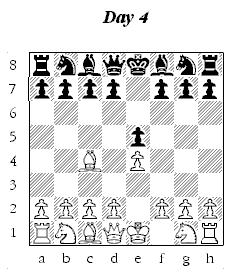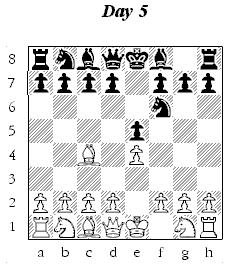1. Catch the King Chess Materials
2. FAQ (Frequently Asked Questions)
3. Teacher & Classroom Questions
4. Introductory Email Chess (Practice Session)
5. Consultation & Tandem Chess
6. Puzzles (Math Chess & Trivia)
Paul Simon's
"Catch the King"
(Chess For Elementary Schools)
Introductory Email Chess (Practice Session)
Participation is restricted to registered members only!
Registered members must include their password, teacher name, school and grade in the the subject line of the email.
After the class has covered the basics and would like to play a practice game to become familiar with the process of email chess, they may do so with Mr. Simon who will be available to play an introductory session of 10 moves.
These 10 moves are not intended to be a completed game, but to move the students forward in the development of the chess process.
The purpose of this exercise is to acquaint the teachers and students with the process involved in playing a consultation game by email and not to discourage play simply because the class is playing a chess master; the class must keep a record (score) of the moves played, play these moves on the demonstration board, work together in determining their moves, share their ideas, give reasons for their suggested moves, try to determine "what the opponent is up to" i.e. what might be their move.
An example of this process is given below in a hypothetical game to demonstrate how email chess is played at the rate of a move a day;

The first thing that needs to be determined is who gets what colour. This is something that the players need to agree on at the start of the game. The simplest solution is to play two games, one with white and one with black. In our game Mrs. Jane White, En Passant School, Grade 3 will be white and Paul Simon will be black. The class should have the above position set up on their demonstration board at the beginning of the game. When the class has determined what move will be made, play can begin. For example, white sends, 1. (P)e2-e4 . This move is written down wherever you want, e.g. blackboard, personal logs, etc.

Now it's my turn to move. The reply
to white's move should be sent before the end of the day.
The time limit per move is another aspect of play that
the players should agree on before the start of play. The
rate of one move per day is a reasonable time limit,
however some players may wish to adjust this to suit
their own speed of play.
My reply is, 1. ...., (P)e7-e5,
in order to control the centre and free up my bishop and
queen.

The majority of the players in the class decided on, 2. (B)f1-c4.

I think that white wants to set up the Scholar's Mate with, 3. (Q)d1-h5, so I'll just prevent that by playing, 2. ...., (N)g8-f6.

...and play continues from the above position with white to move.

























